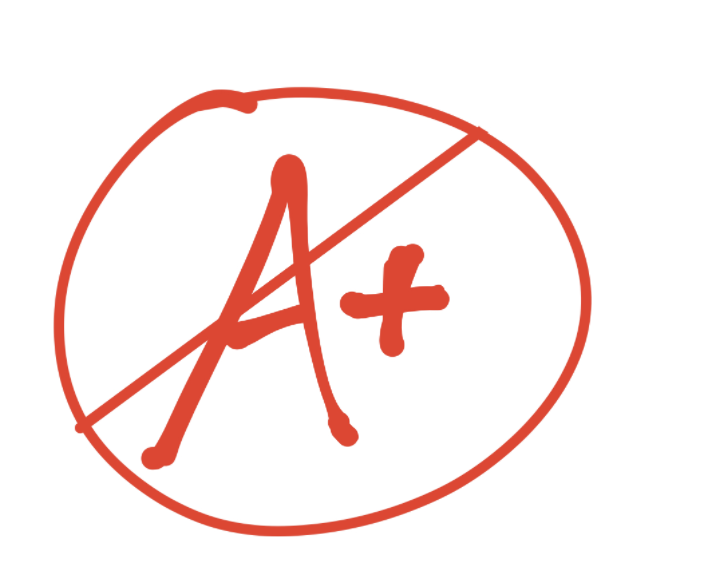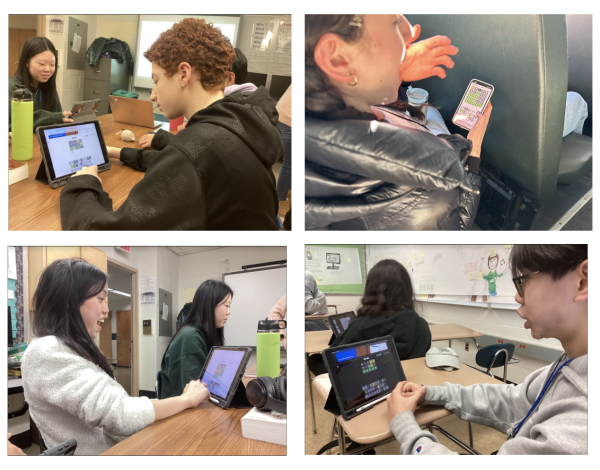A ”Point-Less” Approach to Grades
March 24, 2022
In January of 2020, English teacher Ms. Jennifer Hastings implemented a new assessment system in her classroom, a system that would bring a completely different outlook on grades. For many years, the traditional system created anxiety for both her and her students. Because students were so worried about the points they received, they did not pay as much attention to what they were actually learning. After years of trying a variety of small changes—from teaching mindfulness to allowing revisions—she ultimately decided that to create the kind of learning environment that she desired, she would have to do something more drastic. After researching alternative assessment, she met with building administration and proposed a system that used numbers only for quarter and course grades. A little more than two years later, Ms. Hastings—along with Mrs. Shaw, Dr. Walter, and Mr. Marr—continues to evolve a “point-less” grading system.
How long have you been teaching English?
Mr. Marr: I’ve been teaching English here for one year. And before I taught drama here, I taught English in the city.
Dr. Walter: I’ve been teaching English for over 25 years from grades 6-12.
Ms. Shaw: I’m in my 16th year. I’ve been teaching in this building since 2008.
Ms. Hastings: 16 years. I’ve been teaching here my whole career, since 2006.
What is your opinion on the traditional grading system?
Mr. Marr: I feel that the traditional grading system often misses the point of learning and doesn’t accurately reflect students’ progress in class, especially for a subject like English. What do numbers mean? What is an A? What is a B? Aren’t these things subjective when you’re dealing with students’ expression and communications of their thoughts and feelings about let’s say, literature and grammar? A student might be able to identify the correct verb tense or prepositional phrase or dependent clause in a quiz, but if they don’t apply it to their own writing, what does that 100% show about how much they know about how to use those concepts? It’s a faulty system.
Ms. Hastings: My son is now in middle school. We also have Infinite Campus, and we get notifications and numerical grades on everything. But we don’t know what the numbers mean. Yes, we can see an 80, that’s a B-, but that’s not as helpful as knowing what he did not understand. Is this a matter of him rushing through his test? Or is it a matter of him not understanding the concept? We always follow up with him to look at the tests, but my son tends to focus more on the number than anything else.
Can you give a brief description of your grading system? How does it work?
Ms. Hastings: I still use rubrics. They just don’t have numbers on them anymore, so I use terms to describe progress in the learning standards: advanced, proficient, developing, and inadequate. Through lessons and examples, I help students understand what “advanced” looks like. I also give narrative feedback and concrete “next steps” for revision. And then at the end of the quarter, students will reflect on this progress (using guidelines that I give them ahead of time) and suggest a numerical grade. I compare this suggestion with my data, and then determine a grade based on all of that information.
Dr. Walter: I give feedback to any work that students have submitted, and it’s through Google Classroom. I write in the comments, and I comment on all aspects of their work. When I return those papers, students are always invited to revise it based on my feedback, and that goes for small little homework assignments, long essays, and class discussions.
Mr. Marr: When a student submits something, in the grade goes a word in the score column: complete, late, partial, review instructions, or missing. And then in the comments of Google Classroom or in the document, there will be feedback. At the end quarter, there is self reflection, both data collection and narrative-driven self assessment. I also developed an interactive flowchart to give kids a sense of where they might land in terms of a grade level of A, B, C, D, etc.
Why did you decide to adopt these practices? Is there any experience that inspired you to do so?
Ms. Shaw: Well, for one, I spoke regularly with Ms. Hastings as she was blazing this trail in our department, and my initial reaction was to think, wow, this is bold; this is so huge. But it made sense. I was tired of battling students for points. Plus, I had already, unbeknownst to me at the time, tried to guide my students through a research unit that sought to take their focus away from the due dates and the grades. Having endured many research units in the past, I knew the pressure due dates and grades placed on students made it hard for them to honor the process needed to produce a research-based argumentative paper, which is, let’s be honest, a really hard task. So I had to make this change for them. Sadly, this was not met well because I was still going to give the final paper a grade. And despite their appreciation for this unconventional approach, that final score loomed over them, and me. Furthermore, my experiences as a parent of school-aged children has taught me a great deal about the value of narrative data, which is a huge part of the way elementary school teachers evaluate their students. I have learned how to be a better guide on the side for my own children based on the narrative data their elementary teachers have shared with me. Ultimately, scores don’t tell a story— or maybe they do, but they don’t tell the one I want to tell or have my students hear.
Ms. Hastings: Much of the reason was that I didn’t want to crush children. I didn’t want them to cry about their grades. I didn’t want them to be afraid to take risks and try new things.
How successful would you say your grading system has been so far? Do you believe it has achieved its intended purpose?
Mr. Marr: I’m actually in the middle of trying to figure that out. For the first quarter this year, absolutely. The reflection self assessments that I put out were thoughtful, astute, and accurate. I’m trying to, at the local level, at the grassroots guerilla warfare level, change students thinking about learning. Am I doing a disservice to students by not meeting them at the points that they’re accustomed to? Is there some way to meet them? Is there some hybrid system? Should I do an experimental quarter with points? And again, this is my first year teaching English with this new system, so I’m not sure if I can evaluate my degree of success with this system just yet.
Ms. Hastings: I do. I definitely see, early and often, that my students are less afraid—and they are still really motivated. They do get grades at the end of the quarter, so I’m not under the illusion that they are solely motivated by the learning itself, but I definitely see more engagement in the work, more eagerness to understand how to improve, than I did before I started assessing in this way.
What are some positive outcomes that have come out of point-less grading?
Ms. Hastings: In terms of positive outcomes, one of them is that students can now much better describe what they’ve learned, how they know what they’ve learned, whereas before it was, “I know because I got an A.” And so for that shift, I think it’s really meaningful. They are also much less afraid to take risks in their writing. The worst that can happen is that they get feedback that something isn’t working and they have to revise.
Ms. Shaw: I like how I can finally evaluate their participation in a way that feels right and not limiting. For many years in this building, we, teachers and administrators, have talked about best practices for factoring a participation score into the grade book. And participation is an essential component for any endeavor. By dropping the points-based assessment, I am free to invite students into the evaluative process. I ask them to consider their approach to learning. I talk a lot about what they ought to do, how they ought to think, where they can receive additional support, what they might try next time around (and not for more points but for an improved skill or understanding). The self-evaluative and self-reflective assignments or impromptu conversations generate key details that not only help them to be honest about their learning strengths and needs, but also show me how to better support them along the way. For freshmen, this is especially helpful, as they work to transition to the demands and joys of this building.
Have you changed your practices since you first started implementing them? If so, how?
Ms. Hastings: Two years ago, the first year I did it, the system was very tight. It was like the progress descriptors equated to grades, and there was too much flexibility with revision. Both the students and I were drowning in work. So the next year, I overcorrected: I didn’t really use rubrics; instead, students would set goals and reflect on their progress towards achieving them. But then I was starting to see that the students’ reflections and grade determinations didn’t align with what I was thinking, so I needed to be more direct. When I started this year, I knew I was going to try to find that happy medium between being clear about student progress, while not making it so fixed in terms of what a certain grade looks like. So far, I feel like it’s working, but I will collect anonymous feedback from my students at the end of the year.
Are there any hardships/downsides that you have observed in this way of grading?
Dr. Walter: For some students, it’s really hard not to be given numerical assessments on assignments since they’ve been trained to use that system as a measure of their progress. I think that’s just a function of being uncomfortable with inexperience. It’s also definitely a much more labor-intensive experience on my end, but for me, it’s the work that I want to do.
Are there any changes you intend to make in the future?
Ms. Hastings: I know I will continue to evolve my own record-keeping in an attempt to streamline things as much as possible. This method of data collection is a little more labor-intensive, and I need to create a sustainable system.
Dr. Walter: Not that I know of as of now. But as I’m thinking about it, asking students to reflect on the practice itself and provide feedback is probably a good thing for me to do.
It seems like your practices pertain mainly to English. Do you believe that other subjects should go somewhere along this path as well? If so, how?
Ms. Hastings: I ultimately think that the teacher needs to be able to make decisions that are going to work for them and their students. Do I think it’s awesome if other people want to do it? Yes. Do I think the administration should tell everyone they have to? No. Most people can see more easily how it works in English because it’s a skill-based course, not a content-based course, and I do not have the specific subject-area knowledge to explain how it could work in other subjects. But I do know people are doing it across all kinds of disciplines, so I would say that it’s certainly possible.
















